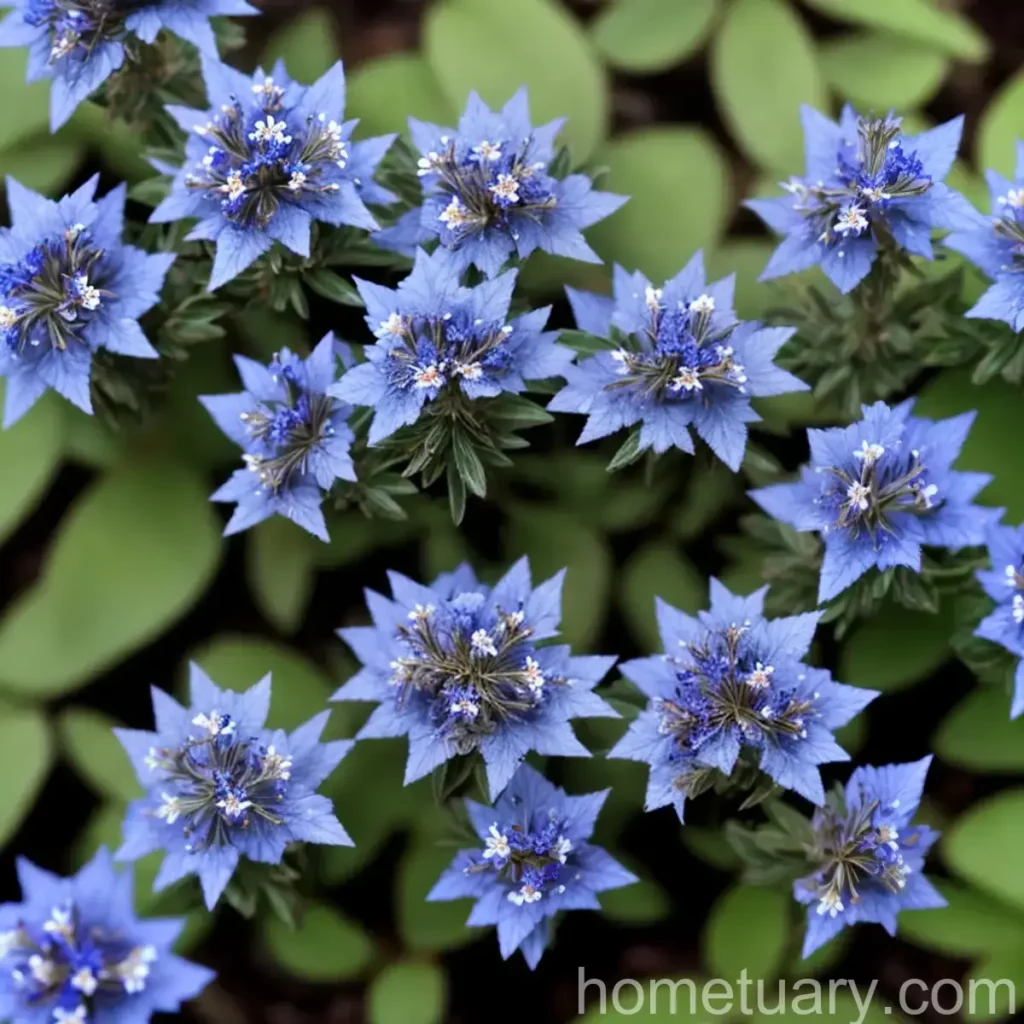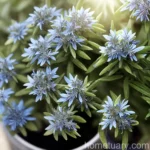All About Lithodora (Lithodora diffusa)
Lithodora (Lithodora diffusa) is a delightful, low-growing evergreen perennial that belongs to the Boraginaceae family. This vibrant, spreading plant thrives in rock gardens, borders, and containers, contributing to beautiful landscapes with its eye-catching blue flowers and glossy green foliage. In this extensive guide, we will delve into the various aspects of lithodora care and maintenance, exploring its cultural requirements, uses, propagation, significance to wildlife, and so much more.
What is Lithodora (Lithodora diffusa)?
Lithodora diffusa, commonly known as Lithodora, is native to the limestone cliffs and rocky slopes of southern Europe, boasting impressive adaptability to various soil and environmental conditions. This charming perennial has gained popularity for its stunning, star-shaped, deep blue flowers that bloom prolifically from spring to early summer.
Key Takeaways – Lithodora (Lithodora diffusa)
Before we delve into the detailed aspects of lithodora care, let’s summarize the key points about this beautiful plant:
- Scientific Name: Lithodora diffusa
- Family: Boraginaceae
- Common Name: Lithodora
- Type: Evergreen perennial
- Flower Color: Deep blue
- Foliage: Glossy green
- Blooming Season: Spring to early summer
- Uses: Ground cover, rock gardens, borders, containers
- Significance: Attracts pollinators, wildlife habitat
- Cultural Requirements: Well-drained soil, ample sunlight, moderate watering
Now, let’s dive into each aspect of lithodora care and maintenance in detail.
Culture
Cultivating lithodora involves understanding its basic cultural requirements to ensure its optimal growth and blooming. Let’s explore the essential elements of lithodora culture.
Uses
Lithodora’s versatility makes it a valuable addition to various landscape settings. Its common uses include:
- Ground cover in rock gardens and borders
- Container plant in window boxes, hanging baskets, and patio pots
- Erosion control on slopes and banks
Water
Lithodora thrives in well-drained soil and requires moderate watering. It is important to avoid overwatering, which can lead to root rot, particularly in heavy or clay soils. During dry spells or hot periods, providing sufficient water is crucial for its health and blooming.
Sunlight
Lithodora prefers full sun to partial shade. In cooler climates, it can tolerate more sun, while in warmer regions, afternoon shade can benefit the plant, especially during the hottest part of the day.
Fertilizer
To support healthy growth and abundant flowering, fertilize lithodora with a balanced, all-purpose fertilizer in early spring, just before the blooming season. However, avoid excessive fertilization, as it can lead to excessive foliage growth at the expense of flower production.
Soil
Lithodora thrives in well-drained, slightly acidic to neutral soil. It prefers loamy or sandy soil types and does not tolerate heavy, waterlogged soils. Amending the soil with organic matter can enhance its drainage and quality.
Pruning
Pruning lithodora is minimal. After the blooming period, trimming back the spent flowers can promote a neater appearance and potentially encourage a light rebloom. However, excessive pruning should be avoided to prevent damage to the plant.
Propagation
Lithodora can be propagated through several methods, including seed sowing, division, and cuttings. Each technique offers an opportunity to multiply this charming plant to expand its presence in the garden or share its beauty with others.
Seed Sowing
Steps for Lithodora Seed Sowing:
- Choose a well-draining potting mix.
- Sow seeds on the soil surface and lightly cover them with a thin layer of the growing medium.
- Water the seeds gently and maintain consistent moisture until germination occurs.
- Transplant the seedlings to their permanent locations once they have developed several true leaves.
Division
Steps for Lithodora Division:
- In early spring, carefully dig up the lithodora plant to be divided.
- Use a sharp, clean knife to separate the root ball into sections, ensuring that each division has both roots and shoots.
- Replant the divisions in prepared soil, water thoroughly, and provide appropriate care to support their establishment.
Cuttings
Steps for Lithodora Cuttings:
- Take 3-4 inch cuttings from the current year’s growth, ensuring they have several sets of leaves.
- Remove the lower leaves and dip the cut end in rooting hormone to improve the success of root formation.
- Plant the cuttings in a well-draining rooting medium and maintain consistent moisture and warmth until roots develop.
Container Popularity
As a delightful, low-growing plant with year-round appeal, lithodora is highly popular for container gardening. Its ability to thrive in containers makes it an excellent choice for enhancing the beauty of patios, balconies, and other outdoor spaces. Additionally, its suitability for hanging baskets adds a vertical dimension to container gardens, creating stunning visual interest.
Common Diseases
Lithodora is generally resistant to most diseases, but it can be susceptible to certain issues under unfavorable growing conditions. Understanding these potential diseases and their prevention can help to maintain the health and vigor of lithodora plants.
Disease Diagnosis
Common Diseases of Lithodora:
- Root Rot: Caused by overly wet soil and poor drainage, leading to the decay of the plant’s roots. Symptoms include wilting, yellowing foliage, and a foul odor from the roots.
-
Prevention and Treatment: Ensure proper soil drainage and avoid overwatering to prevent the development of root rot.
-
Powdery Mildew: Identified by the appearance of white, powdery spots on the leaves, powdery mildew can affect lithodora, especially in humid conditions.
- Prevention and Treatment: Provide adequate spacing between plants to promote air circulation, and avoid overhead watering to reduce humidity around the foliage.
Common Pests
While lithodora is relatively pest-resistant, it may occasionally encounter certain insect pests that can affect its growth and appearance. Recognizing these potential pests and implementing suitable control measures can safeguard the plant from damage.
Common Pests Affecting Lithodora:
- Aphids: These small, pear-shaped insects can congregate on the new growth and flower buds, causing distortion and damage as they feed on the plant sap.
-
Control Measures: Use insecticidal soap or a strong stream of water to dislodge and control aphid populations.
-
Spider Mites: These tiny pests can infest the undersides of leaves, causing stippling and webbing as they feed on the plant’s juices.
- Control Measures: Regularly rinse the foliage with water to deter spider mite infestations, and consider introducing natural predators, such as ladybugs, to manage their populations.
Botanist’s Tips
Caring for lithodora involves understanding and addressing its specific requirements to promote its optimal growth and beauty. Here are some valuable tips from botanists and horticultural experts to ensure the successful cultivation of lithodora.
-
Ensure well-drained soil: Amending heavy or clay soils with organic matter can improve their drainage and create a suitable growing environment for lithodora.
-
Monitor watering carefully: While lithodora appreciates moderate watering, it is important to avoid overwatering, especially in heavy or poorly draining soils.
-
Provide adequate sunlight: Position lithodora in a location that receives ample sunlight, particularly in cooler climates. In warmer regions, afternoon shade can benefit the plant during the hottest part of the day.
Fun Facts
-
Lithodora’s botanical name, Lithodora, is derived from the Greek words “lithos” meaning stone and “doron” meaning gift, which refers to its natural habitat on rocky slopes and its valuable ornamental qualities.
-
The vibrant blue flowers of lithodora are not only visually striking but also attract various pollinators, including bees and butterflies, enhancing the biodiversity of garden landscapes.
Links to External Resources
For further information on lithodora care, propagation, and landscape use, refer to the following external resources:
Conclusion
As a captivating and versatile plant, lithodora (Lithodora diffusa) enchants gardeners with its stunning blue flowers, glossy foliage, and evergreen appeal. By understanding its cultural requirements, uses, propagation techniques, significance to wildlife, and potential challenges, gardening enthusiasts can cultivate and appreciate the beauty and charm of lithodora in a variety of landscape settings. With proper care, lithodora thrives as a resilient and rewarding addition to gardens, rockeries, and containers, illuminating outdoor spaces with its striking visual presence and contributing to the biodiversity and natural appeal of garden environments.
Lithodora diffusa care, Lithodora diffusa plant, Lithodora diffusa growth, Lithodora diffusa characteristics, Lithodora diffusa propagation, Lithodora diffusa maintenance, Lithodora diffusa pruning, Lithodora diffusa varieties, Lithodora diffusa landscape, Lithodora diffusa ground cover, Lithodora diffusa blooming, Lithodora diffusa watering, Lithodora diffusa soil requirements, Lithodora diffusa shade tolerance, Lithodora diffusa sunlight needs, Lithodora diffusa hardiness, Lithodora diffusa diseases, Lithodora diffusa pests, Lithodora diffusa companion plants, Lithodora diffusa container gardening, Lithodora diffusa rock gardens, Lithodora diffusa borders, Lithodora diffusa edging, Lithodora diffusa landscaping ideas, Lithodora diffusa ground cover alternatives, Lithodora diffusa uses, Lithodora diffusa medicinal properties, Lithodora diffusa folklore, Lithodora diffusa symbolism, Lithodora diffusa pollinators, Lithodora diffusa wildlife habitat, Lithodora diffusa native habitat, Lithodora diffusa seasonal changes, Lithodora diffusa decorative features, Lithodora diffusa unique characteristics, Lithodora diffusa drought tolerance, Lithodora diffusa winter care, Lithodora diffusa spring blooms, Lithodora diffusa summer foliage, Lithodora diffusa fall colors, Lithodora diffusa evergreen foliage, Lithodora diffusa plant structure, Lithodora diffusa planting tips, Lithodora diffusa garden design, Lithodora diffusa horticultural uses, Lithodora diffusa soil amendments, Lithodora diffusa ground cover benefits, Lithodora diffusa erosion control, Lithodora diffusa water-wise gardening, Lithodora diffusa container gardening tips
With a comprehensive understanding of lithodora’s needs and attributes, gardeners can fully appreciate its ornamental and ecological contributions, harnessing its beauty to transform and enliven outdoor spaces with its captivating allure.















